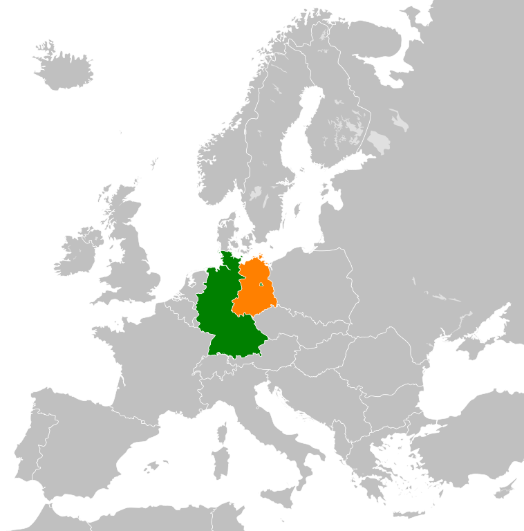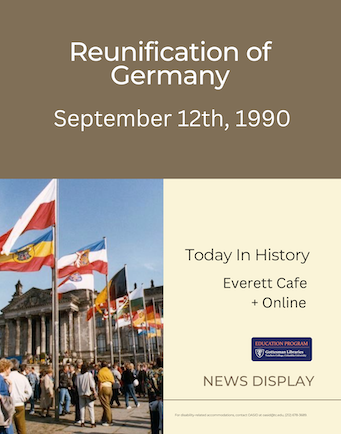Today In History: The Reunification of Germany

Some may remember the former Checkpoint Charlie, a well-known border crossing on Friedrichstrasse in Berlin. Becoming a symbol of the Cold War, with the presence of American and Soviet tanks there at the height of crisis in 1961, this major military point sought to stop emigration and defection, at times unsuccessfully, into the West.
On September 12th, 1990 the former East and West Germany agreed under the "Two Plus Four Treaty" with European Allies (France, Soviet Union, United Kingdom, and United States) that German boundaries comprised the entire area of Germany -- soon to be considered one country. Reestablishing Germany as a single state occurred between November 9th, 1989 and March 15th, 1991, with October 3rd, 1990 as a key date when the Unification Treaty dissolved the German Democratic Republic (also known as the GDR or East Germany). The former German Democratic Republic was viewed as a communist state stemming back to Soviet occupation during Nazi Germany (1933-1945).
This news curation focuses on the close period leading up to, and just after, the Treaty which ushered in the next stages of German reunification -- a major political, social, and economic decision that impacted the fall of the Berlin Wall and larger growth and influence of Western thought, including changes in education.
The following articles are drawn from Proquest Historical Newspapers, which informs and inspires classroom teaching and learning.
- Schmemann, S. (1990, Jan 19). Troubled by Migration From East, Bonn Sharpens Reunification Call. New York Times (1923-)
- Apple, R.W., Jr. (1990, Feb 26). A Disquiet on Germany: Bush and kKohl Struggle for Notes of Calm as the Headlong Rush to Unity Gives Pause. New York Times (1923-)
- Two leaders Narrow Gap on Germany: But Reunification Remains Unsettled. (1990, Jun 01). The Hartford Courant (1923-)
- Marshal, T. (1990, Jun 12). Bonn, Moscow Report Progress on Key Issue: Reunification: The Foreign ministers Move Closer to Resolving Differences Over the Status of a Future Germany. Los Angeles Times (1923-1995)
- Kempster, N., & Jones, T. (1990, Jul 18). Poland, Germany Agree on Border: Reunification: The Settlement Removes the Last Big Obstacle to a Single German State. Los Angeles Times (1923-1995)
- Marshall, T. (1990, Aug 31). Accord Reached on German Unity Treaty: Reunification: The Document Still Requires Ratification. Los Angeles Times (1923-1995)
- Marshall, T. TIMES, S. W. (1990, Oct 02). Focus on the New Germany: Regional Outlook Old Fears Await the Coming of One Germany. Los Angeles Times (1923-1995)
- Kaufman, J. G. S. (1990, Oct 03). After 45 years, Germany Is United: Throngs Celebrate at Midnight; Cheers Are Mixed with Trepidation. Boston Globe (1960-)
- Slevin, P. (1990, Oct 03). Germany Again One Nation: Kohl Promises World 'No Restless Reich'. The Hartford Courant (1923-)
- Hendrix, K. TIMES. (1990, Nov 13). Germany: Facing the Fears: Reunification: A Symposium Organized by the Goethe-Institut and UCLA Questions How the New Germany Will Differ From the Old, Divided One. Los Angeles Times (1923-1995)

Tips:
- Aynsley, Jeremy. Designing Modern Germany. London: Reaktion Books Ltd, 2009. e-book
- Banchoff, Thomas. The German Problem Transformed: Institutions, Politics, and Foreign Policy, 1945-1995 . Ann Arbor: University of Michigan Press, 2010. e-book
- Blanton, T., et al . Masterpieces of History The Peaceful End of the Cold War in Europe, 1989. New York: Central European University Press, 2010. e-book
- Costabile-Heming, Carol Anne., Kristie A. Foell, and Rachel J. Halverson. Berlin : the Symphony Continues : Orchestrating Architectural, Social, and Artistic Change in Germany’s New Capital. Reprint 2013. Berlin : Walter de Gruyter, 2004. e-book
Images:
- Inter-German Locator, Courtesy of Wikimedia Commons
- Poster Image: Bundesarchiv Bild 183-1990-1003-417, Berlin, Flaggen vor dem Reichstag, Courtesy of Wikimedia Commons
Need to keep current, look to the past, teach a topic? The Everett Cafe features daily postings of news from around the world, and also promotes awareness of historical events from an educational context. Be sure to check additional Cafe News postings on the library blog.


